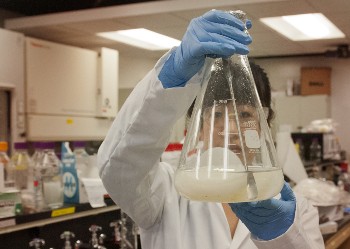Apr 29 2013
Changing the way a plant forms cellulose may lead to more efficient, less expensive biofuel production, according to Penn State engineers.
 Lin Fang, graduate student in agricultural and biological engineering at Penn State, displays a purified microbial cellulose sample in her lab on the University Park campus. Image: Patrick Mansell
Lin Fang, graduate student in agricultural and biological engineering at Penn State, displays a purified microbial cellulose sample in her lab on the University Park campus. Image: Patrick Mansell
"What every biofuel manufacturer wants to do is to get to the sugars," said Jeffrey Catchmark, associate professor of agricultural and biological engineering. "But the structure of cellulose itself can be an obstacle."
Catchmark said that most of a plant's sugar-based energy is locked up in the crystalline structure of cellulose. To make cellulose, plants create long chains of sugar -- glucose -- that are then crystallized and densely packed into tight, ordered bundles resistant to water and other solvents. This bundling may help build strong plant cell walls, but biofuel makers must use extra effort to break down and separate the bundles and the crystalline cellulose to extract the sugars used to ferment fuels.
Using bacteria that produce cellulose as a model to test the process, the researchers discovered an approach for modifying cellulose synthesis in living plants for improved biofuel-making efficiency. During the synthesis process the researchers added glucomannan, a complex carbohydrate found in plants that sticks to cellulose, and found that it altered the structure and assembly of the cellulose, allowing it to be broken down more efficiently.
Another method to ensure the glucomannan is added during cellulose formation requires genetically engineering the plant to express or over-express the enzymes that form the glucomannan, according to the researchers, who applied for a provisional patent on the process.
"In our work, what we are interested in is whether we can improve digestibility by altering the crystal structure or by altering the bundle formation," said Catchmark, who worked with Lin Fang, graduate student in agricultural and biological engineering.
By growing plants with cellulose that is less crystalized and that has fewer structured bundles, biofuel manufacturers will not need to spend as much time and effort breaking down these pre-treated plants, according to the researchers. Currently, biofuel manufacturers must use several industrial processes that are time- and energy-intensive and relatively expensive, including chemical, mechanical and fermentation, to break down the cellulose and separate other materials.
Catchmark said that biofuel manufacturers may be able to further optimize production processes to suit the modified plants for even greater efficiency.
"This will give biofuel makers more options," Catchmark said. "Hopefully, you will need less effort and lower costs with the pre-treatment, but with improved conversion efficiency."
Catchmark said that while the technique was used on bacteria, it could be adapted to various plant species because both plants and certain bacteria share similarities in how they create cellulose. He said that researchers could use the process in both grass and wood plant species, giving biofuel makers additional options. The researchers now plan to test the methods on plants.
The U.S. Department of Energy supported this work through the Penn State Center for Lignocellulose Structure and Formation.